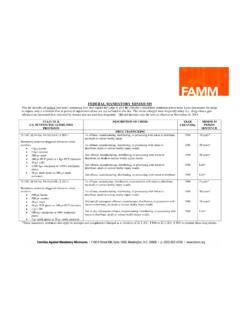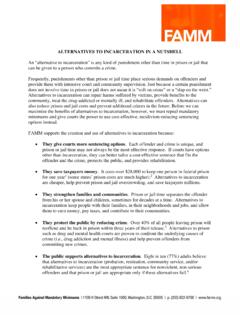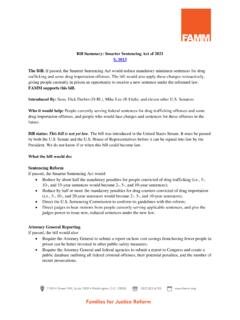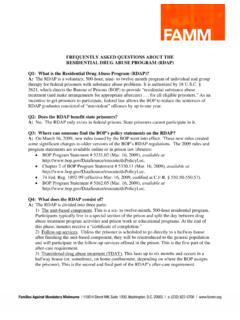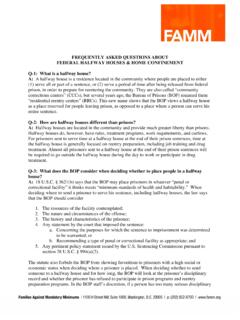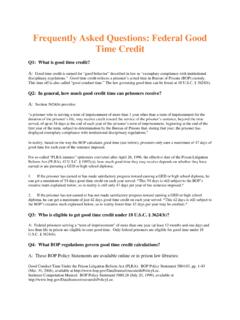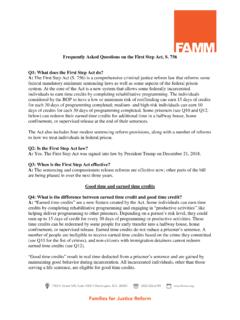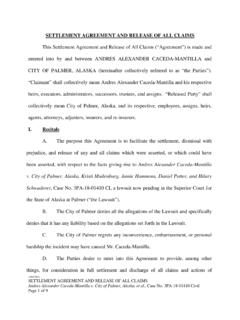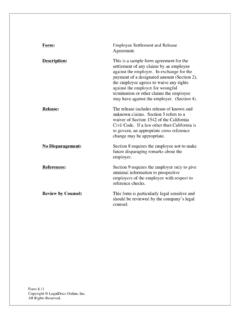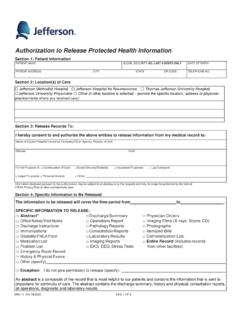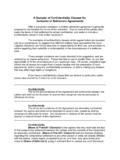Transcription of New Compassionate Release Rules: Breaking it down.
1 Families Against Mandatory Minimums 1100 H Street NW, Suite 1000, Washington 20005 p: (202) 822-6700 New Compassionate Release rules : Breaking it down. On August 12 the Federal Bureau of Prisons (BOP) published new guidelines for the Compassionate Release /Reduction in Sentence program. The guidelines are contained in Program Statement and set out the grounds for Compassionate Release , place new demands on prisoners for documentation in some cases, and set up a system for BOP staff to track requests from prisoners. Congress authorizes Compassionate Release when a prisoner has extraordinary and compelling reasons for it. The BOP can bring a motion to the court asking that the sentence be reduced and the prisoner be released early.
2 The problem: the BOP has, until now, considered few circumstances extraordinary and compelling enough to warrant releasing the prisoner. The BOP has come under sharp criticism for refusing in the vast majority of cases to seek Compassionate Release , even for dying prisoners, as well as for unconscionable delays in processing requests and system-wide chaos in the program. Late last year, FAMM and Human Rights Watch published a sharply critical report, The Answer is No, finding that only a handful of prisoners are released annually, and many die waiting for a decision. FAMM called on the BOP to, among other things, expand Compassionate Release criteria, leave public safety decisions to the courts, and hasten and track applications in medical cases.
3 The Inspector General of the Department of Justice (OIG) followed with a scathing report on the failures and mismanagement of the program. The new guidelines implement some of the recommendations from The Answer is No and the OIG report. They are contained in a Program Statement. It outlines, among other things, 1. What constitutes extraordinary and compelling reasons 2. Additional information prison officials should take into account 3. Information the prisoner (or someone acting for him) must provide to the warden. The new criteria break down into three categories: medical, non-medical, and elderly (which in turn breaks down into medical and non-medical). Please note: this is just a summary of the Program Statement.
4 Anyone interested in pursuing Compassionate Release should read the entire Program Statement. 1. Medical a. Terminal medical condition: requires terminal disease and life expectancy of 18 months or fewer. Whether the condition impairs a prisoner s functioning may be taken into account when considering ability to reoffend. b. Debilitated medical condition: requires incurable progressive illness or debilitating injury with no hope of recovery. Cognitive impairment not required but may be taken into account when considering ability to reoffend. Prisoner must be: 2 Families Against Mandatory Minimums 1100 H Street NW, Suite 1000, Washington 20005 p: (202) 822-6700 i. Completely disabled and totally confined to bed or chair ii.
5 Capable of only limited self-care and confined to bed or chair 50% or more during waking hours. 2. Elderly a. Elderly non-medical i. Prisoners sentenced for an offense committed after Nov. 1, 1987 who are at least 70 years old and have served at least 30 years of their sentence OR ii. Prisoners who are at least 65 and who have served at least 10 years or 75% of the term of imprisonment 1. But ordinarily not eligible if they were sentenced at age 60 or older for a crime of violence (list found in BOP Categorization of Offenses). b. Elderly medical must meet all criteria below i. 65 or older ii. Served 50% or more of sentence iii. Suffers chronic or serious condition related to aging iv. Has deteriorating mental or physical health substantially diminishing ability to function in prison AND v.
6 Treatment will not improve the condition. vi. BOP will also consider the age at offense, if the prisoner suffered from the condition when sentenced, and if the PSI mentioned it. 3. Non-Medical I Need to Care for Child. The BOP will consider Compassionate Release for prisoners whose children are cared for while in prison by a family member who becomes unable to continue care. a. Death or incapacitation of family member who cared for prisoner s child i. Child must be biological or adopted and under 18 AND ii. Person must have died, or have become so ill or been so injured that they are incapable of caring for the child any longer AND iii. BOP decides that releasing the prisoner is in the child s best interests.
7 B. First review stage: Statements and documentation to warden: Note that the BOP will require not only statements laying out the reasons for the request, but also significant documentation from the prisoner seeking a request to be released under this prong, including death certificate or verifiable medical documentation, child(ren) s birth certicate(s) or adoption papers, etc., and written authorization to 3 Families Against Mandatory Minimums 1100 H Street NW, Suite 1000, Washington 20005 p: (202) 822-6700 allow the BOP to gather additional information from other government agencies, doctors, etc. c. Second review: Committee review: If the documentation is sufficient, warden convenes a committee to investigate circumstances and receive supporting documentation and make a recommendation to the warden.
8 This review will among other things: i. Determine how well the child had been cared for previously by the defendant and ii. Verify that the family member is unable to provide care and the prisoner is eligible to obtain custody. d. Special considerations: Additional factors will be used to assess whether releasing the prisoner to parent is in the child s best interest. Prison staff will gather information about any violent conduct in prison, possession of drugs in the child s home, contact with the child since incarceration, evidence of abuse or neglect, whether prisoner has lost parental rights, and other measures of parenting skills, rehabilitation, appropriateness, and availability. 4. Non-Medical II Need to care for spouse or registered domestic partner.
9 The BOP will consider Compassionate Release when a prisoner s spouse or domestic partner ( ) becomes incapacitated and the prisoner is their only available caregiver. a. Incapacitation means a i. Serious injury or debilitating physical illness that completely disables the so that (s)he cannot carry on any self-care and is totally confined to a bed or chair. ii. Severe cognitive defect (Alzheimer s disease or traumatic brain injury) that has severely affected the mental capacity or function but need not be confined to bed or chair. b. First review stage: statements and documentation to warden: The BOP will require statements about the reason for the request, verifiable medical documentation, and written authorization from the prisoner so the BOP can gather information from other government agencies, doctors, etc.
10 C. Second review stage: Committee review: If the documentation is sufficient, the warden then convenes a committee to investigate circumstances and receive supporting documentation and make a recommendation to the warden. This review will cover, among other things: 4 Families Against Mandatory Minimums 1100 H Street NW, Suite 1000, Washington 20005 p: (202) 822-6700 i. The s condition, care before and during the prisoner s incarceration and a determination whether the prisoner is the only family member capable of providing care. ii. Documentation that the wishes the prisoner to be released to provide the needed care. d. Special considerations: Additional factors will be used to assess whether releasing the prisoner is called for.
